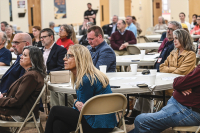Macon comprehensive plan stutters as work begins
Comprehensive planning is supposed to be, well, comprehensive. But as Macon County leaders are finding out, it’s not that easy to get the public’s opinion on how its government should work for the next 20 years.
After a three-month effort aimed at obtaining input on the county’s comprehensive plan, Derek Roland, Macon’s planning director, has only received 303 completed surveys in a county of some 35,000 permanent residents and thousands more second-home owners.
Meanwhile, the subcommittees charged with identifying the issues and action plans that would give shape to the final planning document have been plagued by poor attendance and a lack of a clarity concerning their mission.
“We were notified at our last meeting that there was some disconnect as to what the final outcomes should be,” Roland told a gathering of the subcommittees last week. “I’m hoping we can clear that up before you all leave here tonight.”
The slow start is a testament to the difficulty of the task at hand. The goal of the comprehensive plan is to create a guide for policy decisions concerning the county’s growth. It is addressing 10 different categories ranging from recreation, to land use, to education, to healthcare.
The project was commissioned in January 2009, but hand-picked subcommittees didn’t meet for the first time until October, when they began the process of coming up with recommendations in their specific areas. Since then, the sub-committees have struggled to wrap their heads around the project.
Related Items
Last week, the planning board convened with the subcommittee chairs to regroup and signal a new beginning to the comprehensive planning process.
Chris Hanners, chair of the public services and economic development committee, was frustrated by the poor attendance of his committee members.
“It’s hard to make progress from month to month when you spend half the meeting getting people up to speed on what happened the last time,” Hanners said.
Hanners also said he wasn’t sure what the committee’s final product should look like.
Roland has taken the comprehensive planning process seriously. He has traveled to meetings in Sealy, Cowee, Upper Cartoogechaye, Pine Grove, Otto and Nantahala to explain why this process matters, why it will be different from the county’s two previous failed attempts.
The focus on public input has been his most compelling argument. But after all the meetings, less than 1 percent of the county’s residents have responded to the survey, which is available on-line and at various county and municipal offices.
Roland has already begun crunching the numbers the surveys have yielded and they are interesting, but, ultimately, of little use.
For instance, 72 percent of county residents believe protecting rural character is very important and only 51 percent think the same of recreation facilities.
As planning board member Carl Gillespie, a fifth generation native of Macon County, suggested, the numbers aren’t a clear representation of the public will.
“We need to bear in mind we’re sampling an extremely small percentage of people and we don’t even know what kind of cross-section we’re getting,” Gillespie said.
County Commissioner Bobby Kuppers urged the subcommittee members not to get discouraged.
“The dialogue, the discussion, the identification of problems is worthwhile on its own sake,” Kuppers said. “To this county, this effort means something.”
Planning Board Chair Lewis Penland also took the long view.
“It will always be a work in progress. To be a success it will have to be,” Penland said.
Penland urged the subcommittee members not to get discouraged before their work began in earnest.
“This is new to all of us, and I don’t want people to get discouraged,” Penland said. “The hardest part with a committee like this is to get engaged.”
Penland hailed the planning board’s success in creating a subdivision ordinance for the county as a sign that the comprehensive plan will work.
“The neatest part of all this is that growing up it seemed like there were a few people making decisions in this county and now the tide has changed and the people have the input,” Penland said.
Penland said the surveys were only one layer of the public input process.
“All we can do is deal with what we get,” Penland said. “I don’t know any other way. You can lead a horse to water but you can’t make ‘em drink.”
But it was Roland who addressed the practical side of the planning process.
Using the Henderson County plan –– which has won awards in Raleigh –– as a model, Roland methodically and concisely but energetically outlined the process, including a timeline and a set of concrete outcomes for the subcommittees.
For example, one of Henderson County’s recommendations is to “reduce farmland loss,” and the action strategy was “to consider the costs and practicality of establishing a farmland protection fund for Henderson County.”
The subcommittee chairs left with a clear understanding of what they were being asked to produce and the planning board announced they would extend the public input deadline until March 1 in the hopes of making a last hard push to get the survey numbers up.
“The presentation Derek gave left us with a clear direction, and as of now, I really feel good about the process,” Hanners said.
The subcommittees have the responsibility of settling on a final timeline for their recommendations by the planning board’s May 18 meeting.









